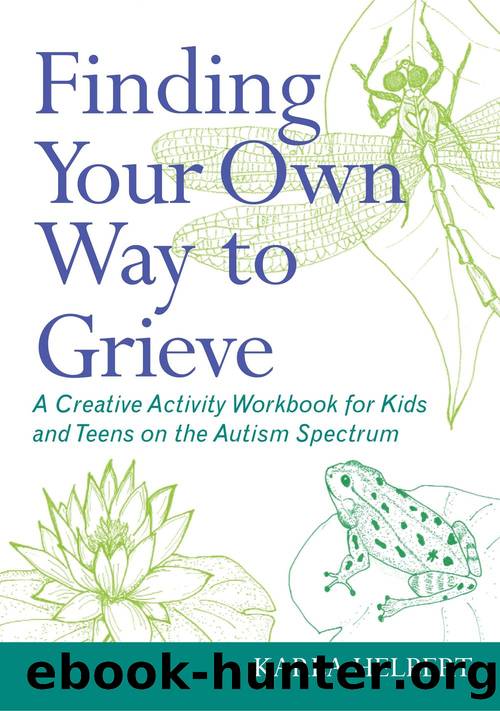Finding Your Own Way to Grieve by Karla Helbert

Author:Karla Helbert [Karla Helbert]
Language: eng
Format: epub
ISBN: 9780857006936
Publisher: Jessica Kingsley Publishers
Published: 2013-06-22T00:00:00+00:00
Thinking About Communication
Are there other types of communication that you can think of? You can write them below.
What are your preferred ways to communicate? You can write them below.
I like to communicate in the following ways:
Are there other ways that you might like to try to communicate? You can write them below.
I would like to try to communicate differently by using these ways:
It is important to remember that for communication to be successful, the person receiving the communication must understand what is being communicated. People with ASD sometimes have difficulty communicating. If you are one of those people, you may feel that others do not understand what you are trying to communicate. Sometimes you may feel that you do not understand what others are communicating to you. Sometimes you may think you know what is being communicated, and then discover you were wrong about what you thought was being communicated. This can be very frustrating.
Sometimes people with ASD can have particular problems with the body movement, or body language, type of communication (number 4 in the types of communications list). This might mean that you have difficulty understanding what someone else is communicating with body language or facial expression. Some people with ASD spend a lot of time trying to figure out what people are communicating with facial expressions and body language. Often the opposite kind of misunderstanding occurs; others may not understand your facial expression or body language. Many people with ASD can have body movements or facial expressions that seem to convey to others a message they have not intended. This usually happens more often if the person with ASD is under stress. For example, if you are feeling anxious or upset, you may laugh or smile instead of having a reaction that might seem more usual to many people. This also happens to other people who donât have ASD.
Stress, and especially grief, because grief is very stressful, can cause people to have reactions they typically would not have. These can show up on your face or in your body movements in ways that others may not understand. Sometimes others may assume (based on what they see on your face or in your body movements) that you are feeling or communicating something entirely different from what you are actually feeling or thinking. This might mean seeming âflat,â or having a kind of blank facial expression, when others might typically expect crying, or very expressive facial movements. A non-ASD (âneurotypical,â or âNTâ) reaction might be to interpret that you are not sad, that you are not feeling upset, or that you donât care, when in fact, you may be feeling something very deeply. Or, you may smile or laugh when you are actually feeling anxious or upset inside. That kind of reaction sometimes is a way to release stress or other painful feelings. Many people can misunderstand this kind of âoppositeâ stress reaction. Sometimes, if this kind of opposite reaction occurs, others may think it means that you are being rude, unfeeling, or uncaring.
Download
This site does not store any files on its server. We only index and link to content provided by other sites. Please contact the content providers to delete copyright contents if any and email us, we'll remove relevant links or contents immediately.
| Allergies | Asthma |
| Autism & Asperger's Syndrome | Cystic Fibrosis |
| Down Syndrome | Eating Disorders |
| Epilepsy | Learning Disorders |
| Lice | Special Needs Children |
I Capture the Castle by Dodie Smith(1579)
Aspergirls by Rudy Simone(1365)
Be Different by John Elder Robison(1334)
Autism's False Prophets by Paul A. Offit(1245)
My Child's Different by Elaine Halligan(1233)
Smart but Scattered—and Stalled by Richard Guare(1198)
What's Making Our Children Sick? by Michelle Perro(1158)
101 Tips for the Parents of Boys with Autism by Ken Siri(1157)
Asperger Syndrome (Autism Spectrum Disorder) and Long-Term Relationships by Ashley Stanford(1118)
ADHD by Mark Selikowitz(1109)
An Adult with an Autism Diagnosis by Gillan Drew(1074)
Girlish by Lara Lillibridge(1072)
Nerdy, Shy, and Socially Inappropriate by Cynthia Kim(1059)
Animal-assisted Interventions for Individuals with Autism by Temple Grandin(1040)
On Immunity: An Inoculation by Biss Eula(1032)
Seeing Ezra by Kerry Cohen(1014)
Overcoming ADHD by Stanley I. Greenspan & Jacob (con) Greenspan(995)
Why Gender Matters by Leonard Sax M.D. Ph.D(984)
Sarah's Child (Hqn Romance) by Linda Howard(983)
